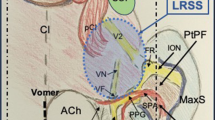Abstract
Background
The use of endoscopes in transnasal surgery offers increased visualization. To minimize rhinological morbidity without restriction in manipulation, we introduced the mononostril transethmoidal-paraseptal approach.
Methods
The aim of the transethmoidal-paraseptal approach is to create sufficient space within the nasal cavity, without removal of nasal turbinates and septum. Therefore, as a first step, a partial ethmoidectomy is performed. The middle and superior turbinates are then lateralized into the ethmoidal space, allowing a wide sphenoidotomy with exposure of the central skull base.
Conclusions
This minimally invasive transethmoidal-paraseptal approach is a feasible alternative to traumatic transnasal concepts with middle turbinate and extended septal resection.






Similar content being viewed by others
References
Briner HR, Simmen D, Jones N (2005) Endoscopic sinus surgery: advantages of the bimanual technique. Am J Rhinol 19:269–273
Friedman M, Caldarelli DD, Venkatesan TK, Pandit R, Lee Y (1996) Endoscopic sinus surgery with partial middle turbinate resection: effects on olfaction. Laryngoscope 106:977–981
Gliklich RE, Metson R (1995) The health impact of chronic sinusitis in patients seeking otolaryngologic care. Otolaryngol Head Neck Surg 113:104–109
Graham SM, Iseli TA, Karnell LH, Clinger JD, Hitchon PW, Greenlee JD (2009) Endoscopic approach for pituitary surgery improves rhinologic outcomes. Ann Otol Rhinol Laryngol 118:630–635
Hopkins C, Gillett S, Slack R, Lund VJ, Browne JP (2009) Psychometric validity of the 22-item Sinonasal Outcome Test. Clin Otolaryngol 34:447–454
Kassam AB, Prevedello DM, Carrau RL, Snyderman CH, Thomas A, Gardner P, Zanation A, Duz B, Stefko ST, Byers K, Horowitz MB (2011) Endoscopic endonasal skull base surgery: analysis of complications in the authors’ initial 800 patients. J Neurosurg 114:1544–1568
Marchioni D, Alicandri-Ciufelli M, Mattioli F, Marchetti A, Jovic G, Massone F, Presutti L (2008) Middle turbinate preservation versus middle turbinate resection in endoscopic surgical treatment of nasal polyposis. Acta Otolaryngol 128:1019–1026
Rice DH, Kern EB, Marple BF, Mabry RL, Friedman WH (2003) The turbinates in nasal and sinus surgery: a consensus statement. Ear Nose Throat J 82:82–84
Thompson CF, Kern RC, Conley DB (2015) Olfaction in endoscopic sinus and skull base surgery. Otolaryngol Clin North Am 48:795–804
Author information
Authors and Affiliations
Corresponding author
Ethics declarations
Conflicts of Interest
Prof. Dr. med. R. Reisch and KD Dr. med. H. R. Briner are consultants of Karl Storz GmbH, Tuttlingen, Germany.
Electronic supplementary material
Below is the link to the electronic supplementary material.
The video “trans-ethmoidal, paraseptal approach to the sella” illustrates the main steps of a minimally invasive, mono-nostril approach to the sella preserving the middle turbinate and the septum, yet allowing a mono-nostril bimanual resection. (MP4 299966 kb)
Rights and permissions
About this article
Cite this article
Reisch, R., Briner, H.R. & Hickmann, AK. How I do it: the mononostril endonasal transethmoidal-paraseptal approach. Acta Neurochir 159, 453–457 (2017). https://doi.org/10.1007/s00701-017-3075-6
Received:
Accepted:
Published:
Issue Date:
DOI: https://doi.org/10.1007/s00701-017-3075-6




